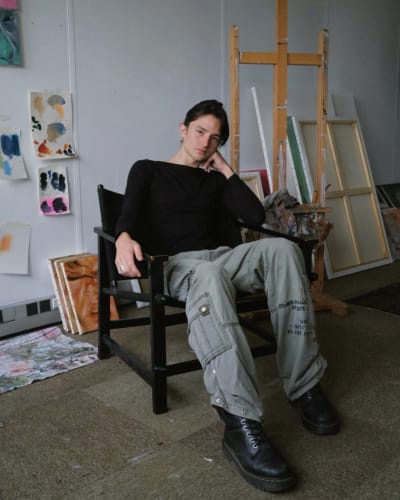Arthur Lemonier is speaking to me from his Parisian studio ahead of his first London show, Of this elusive, I’m an accomplice at TM Projects in collaboration with the Art Office. “[The name] is an ode to my familial heritage, while also referencing themes that are close to my heart.” he tells me. “My father was a huge fan of Mylène Farmer. I finally went to see her in concert at the end of September. The song that both me and my father have loved for so long is Sans Logique, where she speaks about the conflict between her angelic and her evil sides. I’ve always been very attracted to these large-scale concepts, extremes, paradoxes, ideas that complete themselves, so I took the lyrics ‘dans ce paradoxe, je ne suis complice’ and made them more a part of my world.”
The show features a series of new paintings by the Parisian artist, depicting close-ups of faces and bodies in vivid hues of greens, purples and yellows. Lemonier’s subjects live in oscillatory states of agony and ecstasy: faces scrunch up, bodies contort and buckle, flesh is pushed and pulled, eyes roll backwards in fits of saintly rapture. The eyes slide off-canvas, rarely acknowledging the viewer, but their expressions and movements take up entire plots of emotional and physical space. There is an overtly otherworldly tone to Lemonier’s work: the small-scale canvases are taken up entirely by swathes of shining flesh, flashing teeth and sheened skin illuminated by a simultaneously harsh and ethereal lustre, somewhere between the chiaroscuro of Caravaggio and the neon fairytale of gas stations lighting.
“To me, figurative painting has always been a way to identify and explore corporeal connections,” he explains. “That’s where the colors come from; I wanted to deform and explore something that isn’t quite of this world. Flesh-coloured faces don’t interest me. It’s nice for other people, but I just don’t see any correlation between my own interior world and an overtly natural style. Faces are the primary way that people connect. I want them to feel gigantic, omnipresent. I don’t want anything else like the shape of weight of the subjects or their bodies to be known. The small-scale plays really well with this idea, of seeing how far you can push this.”
He also counts Colleen Barry, Chloe Wise and Sasha Gordon amongst his contemporary muses. “I know I’ll be affected by an artist if I go to any exhibition and I lose myself. When I saw Otto Dix’s Portrait of the Journalist Sylvia von Harden (1926) it was the start of something – she was a muse, and very androgynous, it was so emblematic of the 20s and 30s. There’s a term when describing a connection with a painting which is indescribable. I’m not falling into the cliche of this art healed me – I’m too stoic for that – but this painting was a starting point for everything.” Lemonier started painting three years ago, but he admits that his work was “originally much darker” until relatively recently. “I worked with green and black all the time. Then I underwent some changes in my personal life, and there was a shift.” The result was a self-defined system of consciousness and liberation and a renewed interest in research and regeneration. “I hate doing the same thing over and over again!” he laughs.


